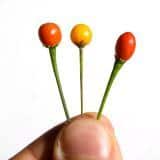… strictly speaking, chiltepin is C. annuum var. glabriusculum; the wild relative of the cultivated C. annuum var. annuum.
However, tepin is also a pod type (among C. annuum), which may or may not be the shape of a C. annuum var. glabriusculum…
Since this is (by and large), a wild type, there are no real varieties, and hardly any landraces.
Yet, neither is there just one single “the” chiltepin. Different accessions from different places do show considerable diversity.
What is more important, anyways, is that chiltepin is the wild ancestor of the whole wide world of C. annuum, “the mother of peppers.” – Well, it’s commonly said like the latter, but that is too general. After all, there have also been domestications of other species. They are still many things:
- Small, spherical, usually ripening red, fiendishly pungent.
- Wild bushes, growing in the North Mexican/Southwest American region
(but to be found even in the Northeast of South America, possibly south to Peru). - Good to grow, but pretty hard to cultivate (at larger scale).
- One of the delicacies harvested in the wild, and one of the most expensive spices.
- One of the ten most-highly threatened foods of the American continent
(and therefore, a member in Slow Food’s “Ark of Tastes”).
So, to sum up:
Botanically, Chiltepines are C. annuum var. glabriusculum (= var. aviculare).
C. annuum var. annuum comprises the cultivated/domesticated group.
As pod type, Chiltepin/tepin means the small, usually red-ripening, but more importantly spherical pods which are typical of C. annuum var. glabriusculum.
This subspecies can also produce pods of (somewhat) different shape, belonging to the pequin pod type.
As popular name, chiltepin, and especially chiltepe, is also used for other kinds of peppers.
Bird Pepper is the most common, most general name for wild peppers and such that look similar. That includes Chiltepin, but also C. frutescensand, with the Charapita type, even C. chinense.
Other posts on Chiltepin:


Leave a Reply
You must be logged in to post a comment.